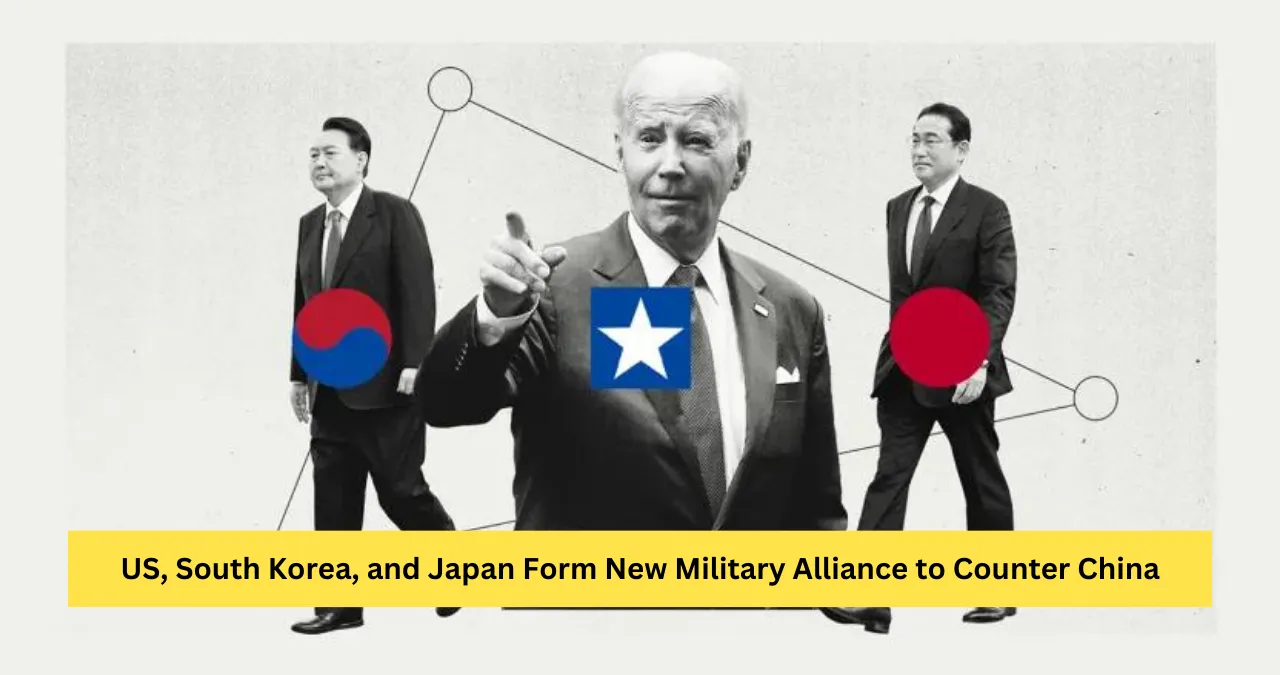US, South Korea, and Japan Form New Military Alliance to Counter China
When Yoon Suk Yeol became South Korea’s president a year ago, US President Joe Biden was dealt a stronger hand in Asia, supporting hawkish security policies that pushed Seoul closer to Tokyo while attempting to reduce friction between the neighbours.
Biden capitalised on those shifts during a historic meeting with Yoon and Japanese Prime Minister Fumio Kishida on Friday at the presidential retreat Camp David. The initial payoff included real initiatives to offset North Korean threats, measures to de-risk global supply networks from China vulnerability, and efforts to bind the trilateral alliance so closely that it would be difficult to break.
All three leaders were hoping for political victories to bolster their domestic political fortunes. Yoon’s conservative party is attempting to retake control of parliament in an April election; Kishida is attempting to reverse a decline in his popularity, which is now hovering around some of its lowest levels since taking office; and Biden is under fire from Republican presidential candidates campaigning to unseat him from the White House.
Here are four key takeaways from the summit:
1.Missile Defence
The three leaders plan to discuss real-time data on North Korean missile launches as they leave Camp David. They will establish a new hotline to share intelligence quickly and launch multi-domain military exercises. Given that a ballistic missile launched from North Korea might reach all of South Korea in a few minutes and most of Japan in less than 15 minutes, being on the same page as soon as possible is critical. When US aircraft carrier groups have been off the peninsula in combined training to shoot down missiles and hunt for submarines, Japan has joined South Korea under Yoon. Making the procedure more formal allows the three countries to better coordinate their response to a crisis.
2.China is riling
The three presidents agreed to a “Commitment to Consult” in order to coordinate responses to “regional challenges, provocations, and threats affecting our collective interests and security.” This is not a treaty to defend each other in the case of an invasion, but it is almost guaranteed to irritate China.
Beijing has accused the US of attempting to establish an Asian alliance like to the North Atlantic Treaty Organisation. Prior to the summit, Chinese experts were quoted in the state-run Global Times as accusing the three of building a “mini-NATO” organisation that would be detrimental to regional security. Its Foreign Ministry will almost certainly issue harsh remarks during a routine briefing on Monday, but whether there will be any economic repercussions for Japan and South Korea — both of whom are Japanese allies — remains to be seen.
While voters in South Korea and Japan are likely to oppose a treaty requiring mutual defence, the two countries are linked by the tens of thousands of American military personnel stationed in both countries, which have security agreements with the US.
3.Economic Security
The decision to launch a trial programme on early warning systems for supply chain shortfalls will aid in mitigating China risk. This could be a sensible compromise, given that South Korea has been a little more hesitant than Japan to join the Biden administration’s trade restrictions aimed at blocking China’s advancement in a variety of cutting-edge technology. South Korean memory chip manufacturers Samsung Electronics Co. and SK Hynix Inc. both rely on China as a key market and manufacturing site.
4.Nuclear Assets
Biden reassured Yoon and Kishida that the US nuclear umbrella is firmly in place, reinforcing American commitments of what is known as extended deterrence – a force powerful enough to persuade an adversary that it cannot achieve its military and political aims by invasion. Yoon and Biden agreed at a conference in April that increased deterrence should result in more deployments of US aircraft groups and submarines capable of firing ballistic missiles to the region. While Pyongyang has reacted angrily to the manoeuvres, the visible displays of US military force near South Korea are certain to continue. Because of the US nuclear attacks on Hiroshima and Nagasaki at the conclusion of WWII, the Japanese populace is significantly more concerned about such developments.



